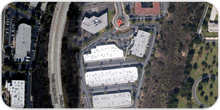NDE/NDI Inspection and Microscopes
Tristan designs and fabricates a range of magnetometer systems to study the magnetic properties of small samples. These are complete research systems that include all electronic components and software analysis tools required to study a wide range of samples. Whether the samples are steel or aluminum plates, composites or even plastics, Tristan NDE systems can measure surface and even deeply embedded sources with a spatial resolution dependent on the type of system constructed .
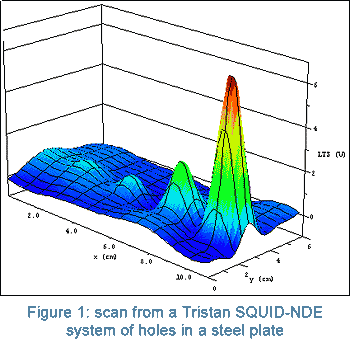
Several standard models are available which have been optimized for different types of measurements. Most systems, however, have a custom magnetometer array that is designed with customer inputs to provide optimum sensitivity for the desired experiment. Optional equipment includes biasing magnets (ac and DC), computer system, scanning stages and data analysis software. Tristan welcomes inquiries for custom and semi-custom systems. Superconducting SQUID sensors can detect induced and intrinsic magnetism as well as electrical currents in materials. As a result, they can be used in a variety of instruments to inspect and analyze materials and structures—on the basis of magnetic signatures—that cannot be effectively measured using competing technologies. These instruments can detect and analyze metallic and non-metallic objects without physically invading or contacting the structure containing them. Sensitivities exceeding 10 fT/√Hz (1 fT = 10-15 Tesla) can be achieved. The flat frequency response and zero phase distortion of SQUID instruments allow for a wide range of applications and minimize the number of instruments required for overlapping measurements.
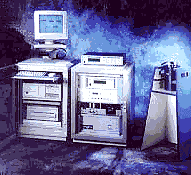
Multichannel LTS SQUID NDE system with dc and ac biasing magnets
Applications for SQUID-based NDE detection include:
Defect Detection in Ferrous and Non-Ferrous Metals
- cracks
- voids
- weld inspection
- stress, strain
- corrosion Insulating Material Analysis
- flaw features Bridges, Runways,Buildings
- corrosion in reinforcing rods
- embedded sensors Aerospace
- corrosion
Embedded Sensors in Composite Structures
Nanoparticle Detection
Food Processing
Pharmaceutical Manufacturing
System Components
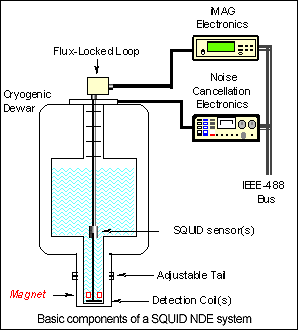 Tristan offers NDE systems based on both liquid helium (LTS) (pdf) and liquid nitrogen (HTS) (pdf) SQUIDs. The more sensitive (<10 fT/√Hz) LTS SQUID uses a discrete detection coil that is typically wound as a gradiometer to improve signal-to-noise. LTS coils can be remote from the SQUID sensor and can operate in tesla applied fields. HTS sensors have the advantage of operating in liquid nitrogen, but suffer from reduced sensitivity (<100 fT/√Hz) and the inability to operate in tesla fields. HTS sensors are available as a pure magnetometer. Basic systems include the probe and dewar assembly as well as SQUID electronics. Options include additional SQUID Channels, DC bias magnet, ac bias magnet, a computer control system and an X-Y positioning table. DC fields up to 1000 gauss and ac fields up to 2 gauss are available with different magnet options. Basic systems can also be configured with a number of different detection coil designs. Sensitivities range from a few fT/√Hz (LTS) to <100 fT/√Hz (HTS). The computer control options include a Windows™-based control system for data acquisition and control of all system parameters.
Tristan offers NDE systems based on both liquid helium (LTS) (pdf) and liquid nitrogen (HTS) (pdf) SQUIDs. The more sensitive (<10 fT/√Hz) LTS SQUID uses a discrete detection coil that is typically wound as a gradiometer to improve signal-to-noise. LTS coils can be remote from the SQUID sensor and can operate in tesla applied fields. HTS sensors have the advantage of operating in liquid nitrogen, but suffer from reduced sensitivity (<100 fT/√Hz) and the inability to operate in tesla fields. HTS sensors are available as a pure magnetometer. Basic systems include the probe and dewar assembly as well as SQUID electronics. Options include additional SQUID Channels, DC bias magnet, ac bias magnet, a computer control system and an X-Y positioning table. DC fields up to 1000 gauss and ac fields up to 2 gauss are available with different magnet options. Basic systems can also be configured with a number of different detection coil designs. Sensitivities range from a few fT/√Hz (LTS) to <100 fT/√Hz (HTS). The computer control options include a Windows™-based control system for data acquisition and control of all system parameters.
- Electronics
Tristan’s iMAG® series of SQUID components features microprocessor-based multichannel control electronics and advanced fiber-optic-linked flux-locked loop circuits. They offer the performance advantages of DC SQUIDs accessed from the front panel of Tristan’s user-friendly iMAG® controller. All functions of the SQUID system can also be controlled via the IEEE-488 bus.
- Cryogenic Dewars
Both liquid helium and liquid nitrogen dewars are constructed of specially designed and selected materials to minimize their magnetic interactions with the SQUID sensors and detection coils. Dewars capable of 90° and even 180° operation are available They require no routine maintenance and require refilling only once or twice a week. Long hold time dewars can be supplied on special order. The standard dewar can be tipped up to 30° from vertical. Normally, tailed dewars can have the spacing between the outside surface of the tail and the detection system (tail gap) as small as 10 mm for liquid helium dewars and 6 mm for liquid nitrogen dewars. If closer spacing is necessary, an adjustable tail mechanism is available as an option. This allows the gap to be as small as 2 mm in some cases. Special mounting allows appproaches to <100 μm.
Detection Coil Topologies
Tristan offers a wide range of coil configurations. Coils a) – e) can be used with biasing coils (magnets) for DC susceptibility, ac and pulse measurements.
- Axial Gradiometer Coils
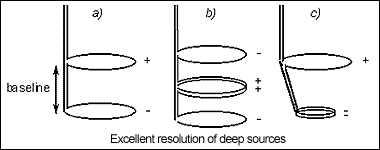 a) Symmetric (First-order) Gradiometer -reasonable noise rejection and sensitivity to nearby sources. b) Second-order Gradiometer – better noise rejection but the sample to be measured must be closer to achieve good sensitivity. c) Asymmetric Gradiometer – Good sensitivity to local signals and reasonable noise rejection.
a) Symmetric (First-order) Gradiometer -reasonable noise rejection and sensitivity to nearby sources. b) Second-order Gradiometer – better noise rejection but the sample to be measured must be closer to achieve good sensitivity. c) Asymmetric Gradiometer – Good sensitivity to local signals and reasonable noise rejection.
- Planar Gradiometer Coils
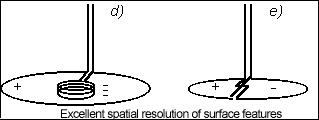
d) Radial Gradiometer – Good sensitivity to local signals and reasonable noise
e) “Double-D” Planar Gradiometer – excellent spatial resolution. Combining two sets of planar coils stacked with one rotated 90 degrees provides the best capability to localize spatial features.
- Synthetic Gradiometers
Combining two HTS magnetometers electronically and subtracting their outputs can be used to create a virtual axial gradiometer. This form of noise cancellation can be extended to more sophisticated schemes for improvement in LTS and HTS systems.
Key to any measurement is ensuring that the detection circuitry is optimized for the measurement being performed. It is critical to determine the relative importance of spatial resolution, sensitivity and noise rejection to determine the optimum system. The design tradeoffs are summarized below: If spatial resolution is most important,the area of the SQUID loop can be optimized for the spatial resolution desired. However, it is important to note that there is no advantage to making a detector loop (SQUID diameter) significantly smaller than the smallest possible spacing between the sample and detectors. If sensitivity is most important,then the detector size should be increased, which usually results in a loss of spatial resolution. For small samples, the larger coil may actually provide inferior signal-to-noise ratios since it will not be as well coupled to the detector. If rejection of ambient noise and immunity to liftoff effects is most important,then the pickup coils should usually be some form of higher order gradiometer design. Special coils are available that are optimized for specific purposes, such as rejecting ambient noise or providing immunity to liftoff effects.
Options
You may purchase a variety of options to enhance the performance of this system, either now or in the future. These include:
- Computer Control
A state-of-the-art Windows™-based control system that allows control of all system parameters, data acquisition and analysis.
- DC Bias Field
Integrating a DC magnet with the detection coils allows fields up to 1,000 gauss to be applied to the sample. With just the DC bias field, magnetically weak samples can be studied. Coupling the DC bias and ac excitation, many types of metallic samples can be studied using eddy current mapping.
- ac Excitation Field
This option allows you to apply ac fields up to 2 gauss to your sample while collecting data. This option includes an ac magnet power supply, waveform function generator and software additions to allow automatic control of the ac magnet.
- ac Nulling Circuit
Special circuitry to generate in-phase and quadrature feedback signals to null the ac signal from the biasing magnet at each SQUID input. This circuitry is able to null ac signals of any amplitude up to the full-scale output of the SQUID magnetometer and it provides 12 bits of attenuation. The quadrature null is generally used to null the eddy current response when applying ac fields to conductors. Defects in the test sample then show up as large changes in the ac output of the system as a flaw is scanned under the magnetometer.
This option includes all necessary modifications to the magnetometer probe and SQUID electronics to allow injection of the ac null signal directly into the input circuit and software to automatically optimize the feedback signal. The ac bias field and the nulling circuit noise cancellation are integrated to provide a seamless measurement in the presence of external noise and ac excitation. Only Tristan offers the sensitivity of dc SQUIDs coupled with ac excitation.
- Automated Scanning Stage
The automated scanning stage allows the researcher to scan samples over a preprogrammed set of X-Y coordinates. Samples up to 50 kg in weight can be scanned over a 30 x 30 cm region.
- Liftoff Measurement
This option allows measurement of the spacing between the magnetometer and the sample) with sub-micron precision.
- Software
Custom software can be supplied to control critical system components, acquire data from the SQUID and analyze the data to determine magnetic properties of the sample being tested. Four classes of automated data acquisition procedures (Timed Mode, Remote Trigger, Auto-scan and High-Speed Scan) are provided in addition to the Manual Trigger Mode.
Post processing functions include Filter (low-pass, high-pass and band-pass), Decimate, FFT, Average, Amplitude, Slope (Differential Magnetic Susceptibility), Area (Magnetic Hysteresis), and Phase-Sensitive Detection (in-phase and quadrature signal components). A variety of data plotting functions (Time, X-Y, Contour, 3-D Contour) are also provided.
Series 600 Systems
Tristan offers two standard product lines—the series 600 LTS systems and the series 700 HTS systems. The series 600 is designed for the researcher who desires ultimate performance from a low to medium count SQUID magnetometer or gradiometer. The series 600 offers the widest choice of detection coil configurations. The series 700 HTS magnetometers offer researchers interested in HTS (liquid nitrogen) SQUIDs a number of convenient platforms to perform NDE measurements.
- Model 601 Single Channel Gradiometer
The T601 includes a Cryogenic Probe with liquid helium level sensor, a 1st order axial (dBz/dz) detection coil, iMAG® LTS SQUID and electronics (1 channel) and a Model BMD-9 Liquid Helium Dewar. With a 1 cm detection coil, sensitivities approaching 10 fT/√Hz are possible. The BMD-9 dewar allows the detection coils to be placed within 10 mm of room temperature.
- Model 603 Three Channel Gradiometer
The 603 is a three channel system with the detection coils oriented orthogonally. To reduce external noise, the coils are configured as one axial and two planar gradiometers (dBz/dz, dBx/dz, dBy/dz). With 1 cm detection coils, sensitivities of 10 fT/√Hz are possible. The 603 can also be ordered with all axial detection coils.
- Model 606 Noise Cancellation Gradiometer
The 606 (Fig. 1) is an extension of the model 603 with the addition of three channels (Bx, By, Bz) for electronic noise cancellation. System noise is dependent on the electronic noise cancellation implementation, but 10 fT/√Hz is expected.
- Options
Options for the Series 600 LTS magnetometers include 2 mm detection coils, 1st and 2nd order axial and planar gradiometer detection coils, improved uniform field noise rejection, an adjustable tail to permit 2 mm tail gaps, scanning stages, liquid helium level monitors and flexible transfer tubes.
- Custom LTS Systems
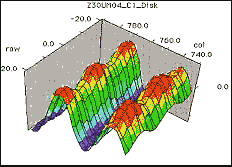
Scan from a Tristan Scanning SQUID Microscope of data on a computer hard drive. The scale is in µm.
Tristan has built many custom NDE systems including the SMM-1000, the world’s first scanning SQUID microscope with a resolving power better than 1 µm.
Series 700 Systems
- Model 701 HTS Handheld Magnetometer
The 701 is a compact single channel magnetometer system. Its 3″ diameter liquid nitrogen dewar has a hold time greater than 16 hours. The NLD-310 dewar allows the detection coil to be within 5 mm of room temperature. The 701 is also available with the 5″ NLD-510 dewar for three day hold times.
- Model 703 Three Channel HTS Magnetometer
The 703 is a small (5″) three channel magnetometer system. The detection coils can be configured axially, orthogonally (Bx, By, Bz) or configured for electronic noise cancellation.
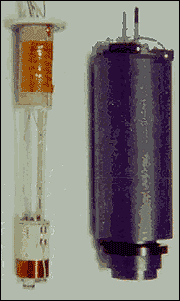
Model 703 with ac/DC bias coil and adjustable tail.
- Options
Options for the Series 700 HTS magnetometers include tailed dewars, inserts with ±90° dewar orientation, an adjustable tail to permit <5 mm tail gaps, scanning stages, external magnets, additional sensors to form electronic gradiometers and LN2 level readouts.
Tristan NDE Systems
If your needs are unique, contact us to discuss your particular requirements. Tristan’s decades of experience working with research scientists, and an ever-increasing quest for refinement of its product lines, ensures that Tristan can manufacture the ideal NDE system to suit your needs.

